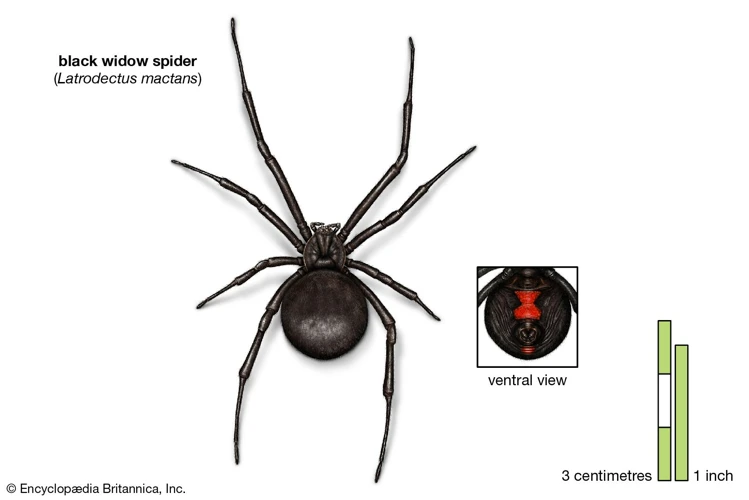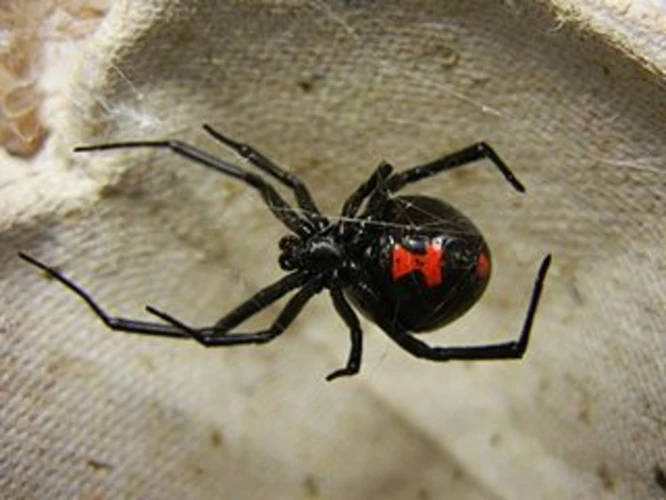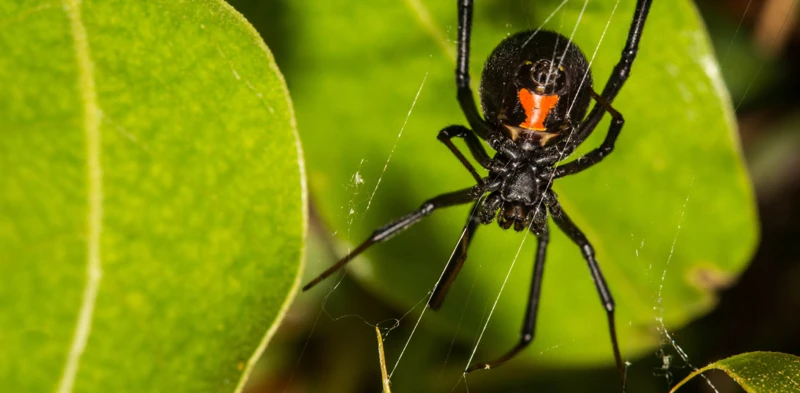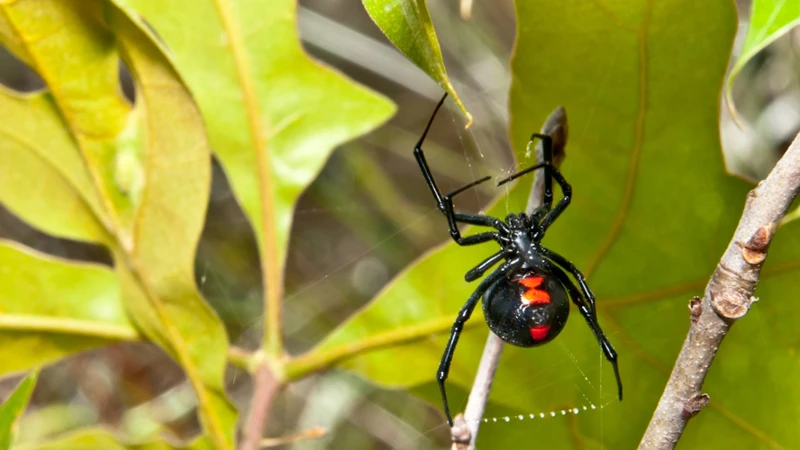Introduction

Black widow spiders are a fascinating yet potentially dangerous species that has piqued human interest for many years. Their distinctive appearance and infamous reputation make them stand out among other spider species. In this article, we will explore the conservation status of black widow spiders, their importance in the ecosystem, and the threats they currently face. We will also discuss ways in which we can help protect these creatures from extinction. So, buckle up and let’s dive into the world of black widow spiders.
What are black widow spiders?
Black widow spiders are highly venomous arachnids that belong to the genus Latrodectus. They are commonly found in warm and temperate regions throughout the world, including North America, Australia, and southern Europe. Female black widow spiders are known for their distinctive black-colored bodies with a red hourglass-shaped marking on their bellies.
The venom of black widow spiders contains a neurotoxin that can cause severe muscle pain, cramps, sweating, and other symptoms in both humans and animals. While black widow sightings are rare, encounters with them can be dangerous, especially for individuals with weakened immune systems.
Here are some interesting facts about black widow spiders:
- Black widow spiders are the most venomous spiders in North America.
- There are over 30 known species of black widow spiders worldwide.
- Male black widow spiders are much smaller in size than females and lack the distinctive black and red markings.
- Black widow spiders are known for their characteristic web-weaving patterns and distinctive egg sacs.
- Black widow spiders are not aggressive and typically only bite when they feel threatened or disturbed.
It is important to note that while black widow spiders can be dangerous to humans, they also play an important role in the ecosystem by controlling insect populations. It is crucial to understand the importance of black widow spiders in our environment and to take measures to limit our impact on their habitats.
Why should we care?

The question of why we should care about black widow spiders may arise for some people. However, these arachnids play an important role in the ecosystem and their conservation is crucial. Not only that, but black widow spiders can also have a significant impact on humans, making it essential for us to understand their behavior and conservation status. It is vital to delve deeper into the reasons behind why we need to pay attention to the conservation of black widow spiders.
Importance of black widow spiders in the ecosystem
Black widow spiders play a significant role in the ecosystem as a natural form of pest control. They help keep other insect populations in check, such as flies, mosquitoes, and grasshoppers. These arachnids are also a source of food for many other species, including birds and reptiles. Prey reduction by black widow spiders can have a positive impact on the vegetation in the area, as it reduces the damage done by herbivorous insects.
Interestingly, black widow spiders have been found to have a wider range than previously thought. Some studies have shown that they have expanded their range due to human activity (source), while others have mapped their distribution in different regions worldwide (source). Black widow spiders are even found in high altitude regions such as in the Andes Mountains (source), and they have been introduced to places outside of their native range, such as in Australia (source).
Despite their importance in the ecosystem, black widow spiders have a notorious reputation among humans due to their venomous bite (source). However, bites are relatively rare and only occur when the spider is provoked or feels threatened. This fear has led to the use of pesticides which has caused negative consequences in the environment, including harming other beneficial insects.
Given their significance in the ecosystem, it is important to protect black widow spider populations and find a way to coexist with them.
Their impact on humans
Black widow spiders have long been feared by humans due to their venomous bite. Only the female black widow spider has venom potent enough to cause harm to a human. The venom contains a neurotoxin that can have serious effects on the body, including muscle pain, cramps, and spasms, as well as nausea, vomiting, and difficulty breathing. The bites can be especially dangerous for young children, the elderly, and those with weakened immune systems.
According to research, climate change can play a role in the distribution and abundance of black widow spiders. As temperatures change, it can affect the spiders’ reproductive biology, survival rates, and the availability of their prey. This means that in areas where temperatures are increasing, black widow spiders may become more common, posing a greater risk to humans.
However, it’s important to note that black widow spiders don’t actively seek out humans to bite. In fact, they are reclusive by nature and will only bite as a last resort if they feel threatened. Most bites occur when a person accidentally disturbs a spider that is hiding in a dark, warm location such as a shoe, clothing, or woodpile.
Despite their reputation as dangerous pests, black widow spiders actually play an important role in controlling insect populations. They are natural predators and can help to reduce the number of other pests in your yard or garden. It’s important to strike a balance between the potential risks and benefits of having black widow spiders in your area, and to take appropriate steps to minimize the risk of bites.
Here are some tips:
| Tip | Description |
| 1. | Wear gloves and long-sleeved clothing when working outdoors, especially in areas where black widow spiders are known to live. |
| 2. | Shake out clothing, shoes, and bedding before using them, especially if they have been stored in a garage or shed. |
| 3. | Avoid reaching into dark, secluded areas without first checking for spiders. |
| 4. | Use caution when moving firewood, rocks, or other materials that could be hiding black widow spiders. |
| 5. | If you are bitten by a black widow spider, seek medical attention immediately. |
By following these simple steps, you can help to reduce the risk of black widow spider bites while also promoting a healthy ecosystem in your area.
Conservation status of black widow spiders

The conservation status of black widow spiders is a matter of concern for many conservationists due to the decreasing population of these venomous arachnids. Known for their black and red appearance and deadly bite, black widow spiders play a vital role in the food chain and ecosystem, particularly in the Americas where they are prevalent. However, due to various factors that threaten their existence, the black widow spider’s conservation status has been in question. In this article, we will delve into the current conservation status of black widow spiders, the role of the IUCN, threats to their population, and current conservation efforts. We will also explore ways in which we can contribute to the preservation of these species and the habitats they reside in. Let’s dive in and discover more about black widow spider conservation.
The role of IUCN in assessing conservation status
The IUCN Red List of Threatened Species is widely recognized as the most comprehensive and objective global approach for evaluating the conservation status of plant and animal species. The IUCN (International Union for Conservation of Nature) uses a set of criteria to determine the conservation status of species based on the best available scientific information. The criteria take into account a range of factors such as the population size and trends, geographic range, habitat quality and quantity, and potential for genetic variation. The conservation status of a species is then assigned one of the following categories: Least Concern, Near Threatened, Vulnerable, Endangered, Critically Endangered, Extinct in the Wild, or Extinct.
In the case of black widow spiders, the IUCN has not assessed the conservation status of any particular species due to the lack of sufficient information. However, it is important to note that the genus Latrodectus, which includes black widow spiders found throughout the world, has been assessed as a whole and is currently designated as Least Concern on the IUCN Red List.
While black widow spiders are not currently at risk of extinction, it is important to monitor their populations and the threats they face. This is particularly relevant for species of black widow spiders that have limited ranges or are found in localized habitats. One example of a localized habitat is the coastal sand dunes of the western United States, where the Western black widow spider (Latrodectus hesperus) is found. This species has not been assessed individually by the IUCN, but it is considered a Species of Concern by the United States Fish and Wildlife Service due to habitat loss and fragmentation caused by urbanization, as well as the use of pesticides and other chemicals.
It is clear that the IUCN plays an important role in assessing and monitoring the conservation status of species worldwide, including black widow spiders. While the current status of these spiders may not be a cause for immediate concern, continued efforts to monitor population trends and address threats are necessary to ensure their long-term survival.
Threats to black widow spiders
Black widow spiders are facing various threats that put their survival at risk. These threats include:
- Habitat loss: As humans continue to develop and urbanize land, the natural habitats of black widow spiders are decreasing. This loss of habitat affects their ability to find suitable places to live and hunt for food.
- Use of pesticides: Pesticides used in farming, gardens, and in urban areas can be lethal to black widow spiders. Even if they don’t consume the poisoned insects, they can still be affected by the chemicals. This can lead to a decline in their population.
- Competition with invasive species: Invasive species outcompete the black widow spider for resources, such as food and shelter. This can lead to a reduction in their population as they struggle to survive in areas with limited resources.
- Illegal trade: Some species of black widow spiders are illegally traded in the exotic pet trade. This not only harms the individuals that are captured and traded but also reduces the number of individuals in the wild.
These threats are not just specific to one region or species of black widow spider. Both North American black widow spiders and global black widow spiders face similar threats. As urban areas continue to expand, black widow spiders are also facing new challenges in urban areas. It is crucial to take action to protect and conserve these species.
Current conservation efforts
Black widow spiders have been recognized as an important part of the ecosystem. Several organizations have stepped up to ensure their conservation. Some of the current conservation efforts are:
| Organization/Group | Efforts |
|---|---|
| IUCN | Regularly assesses the conservation status of black widow spiders and other species to inform conservation decisions. |
| National Park Service (NPS) | Designates and protects vital habitats within their parks where black widow spiders can thrive. |
| The Nature Conservancy | Promotes habitat conservation for black widow spiders and other species by working with private landowners and government agencies. |
| Spider Conservation Program | Aims to conserve spiders, including black widows, by conducting research to better understand their ecology and advocating for their conservation. |
These organizations and their efforts have contributed significantly to the conservation of black widow spiders and their habitats. It is important that individuals also take steps in their daily lives to help in the conservation efforts. Some simple actions include:
- Reducing pesticide use: Pesticides can harm black widow spiders and other beneficial species. Using natural pest control methods instead can help protect them.
- Creating suitable habitats: Individuals can create habitats for black widow spiders and other beneficial species in their yards or gardens by planting native plants, creating brush piles, and providing water sources.
- Reporting sightings: Reporting black widow spider sightings to local authorities or conservation organizations can help in identifying and protecting their habitats.
By taking these actions, we can all contribute to the conservation of black widow spiders and ensure their continued existence in the ecosystem. For more information on suitable habitats for black widow spiders, check out our article on habitat requirements for black widow spiders.
How can we help?
As humans, we have a responsibility to protect and conserve the diverse array of species that inhabit the planet with us. When it comes to black widow spiders, there are several actions we can take to ensure their survival and support their populations. By reducing pesticide use, creating suitable habitats, and reporting sightings, we can make a significant impact on the conservation status of black widow spiders. In this section, we will explore these actions in detail and discuss why they are crucial for the survival of these fascinating arachnids.
Reduce pesticide use
One of the most effective ways we can aid in the conservation of black widow spiders is by reducing our use of pesticides. Pesticides are chemicals that are designed to kill insects, but they do not always discriminate between harmful and non-harmful species. By reducing pesticide use, we can help maintain a healthy ecosystem for black widow spiders and other beneficial insects.
The Impact of Pesticides on Black Widow Spiders
Pesticides are one of the biggest threats to black widow spiders. These chemicals can kill the insects that the spiders rely on for food, as well as directly harming the spiders themselves. The overuse of pesticides has also led to the decline of other beneficial insects, which in turn can make the black widow spider’s food sources scarce.
Ways to Reduce Pesticide Use
There are several ways you can reduce your use of pesticides and help protect black widow spiders.
| Tip | Explanation |
|---|---|
| Use Natural Alternatives | Instead of using chemical pesticides, try natural alternatives like diatomaceous earth or neem oil. These products are just as effective in controlling pests, but they are much less harmful to black widow spiders and other beneficial insects. |
| Plant Native Species | By planting native species in your garden, you can help attract beneficial insects that will naturally help control pests. Native plants are also adapted to local conditions, making them more resistant to pests and better able to support a healthy ecosystem. |
| Practice Integrated Pest Management | Integrated pest management is a holistic approach to pest control that involves monitoring and controlling pest populations through a variety of methods, including biological controls and cultural practices. By following this approach, you can reduce your reliance on chemical pesticides and help protect black widow spiders and other beneficial insects. |
| Avoid Overuse of Pesticides | Before using pesticides, make sure they are necessary and that you are using the correct amount. Overuse of pesticides can harm beneficial insects and create resistance in pest populations, making them harder to control over time. |
Take Action Today
Reducing your use of pesticides is a simple but effective way to help protect black widow spiders. By making small changes in our daily lives, we can all play a role in preserving these amazing creatures for future generations.
Create suitable habitats
One way to help conserve black widow spiders is to create suitable habitats for them. This can be done by providing the right conditions for their survival and reproduction. Here are some ways to create suitable habitats for black widow spiders:
- Provide shelter: Black widow spiders need shelters to hide from predators and protect themselves from harsh weather conditions. You can create shelters for them by placing rocks, logs, and other objects in your garden or yard.
- Plant native vegetation: Black widow spiders rely on native vegetation for shelter and food. You can help them by planting native plants that are suitable for your local climate.
- Reduce pesticide use: Pesticides can harm black widow spiders and their food sources. By reducing pesticide use in your garden or yard, you can create a safer environment for these spiders.
- Provide water: Black widow spiders need water to survive. You can create suitable habitats for them by providing a water source such as a shallow dish or fountain.
Creating suitable habitats for black widow spiders not only benefits these spiders, but also the ecosystem as a whole. By providing them with suitable habitats, we can help maintain the balance of nature and promote biodiversity.
Report sightings
It is important to report any sightings of black widow spiders in your area to help conservation efforts. By reporting their presence, scientists and researchers can better understand the spider’s distribution and behavior, as well as their current population status.
Here are some steps you can take to report sightings of black widow spiders in your area:
- Document the sighting: Take a clear photo of the spider and note down the location, date, and time of the sighting. This information can help experts to verify the identity of the spider and to track its movements.
- Contact local wildlife authorities: Reach out to your local wildlife authorities, such as the state or provincial park or the local conservation group. They will be able to provide further information on how to proceed with reporting the sighting.
- Use online resources: Many wildlife organizations have online reporting tools that allow you to easily submit your sighting and information. For example, The Spider Identification Chart is a database created by the University of California, Davis that allows users to report spider sightings.
- Share with your community: By sharing your findings with your local community, you can encourage others to also report any black widow spider sightings they may come across. This can foster a collaborative effort towards spider conservation.
Reporting black widow spider sightings is crucial for their conservation status, as it helps experts to better understand their distribution and population status. By taking the time to report any sightings, you can play an active role in supporting the conservation of these important spiders.
Conclusion
In conclusion, while black widow spiders may be feared by many, they play an important role in the ecosystem. The conservation status of these arachnids is currently of concern, with their populations being threatened by various factors including habitat loss and pesticide use. The IUCN has recognized the need to assess their conservation status and implement measures to protect them.
It’s important that we acknowledge the significance of these creatures and take steps to preserve their populations. As individuals, we can reduce pesticide use, create suitable habitats, and report sightings to help with conservation efforts. By doing so, we can ensure the survival of black widow spiders and contribute to maintaining a healthy ecosystem.
Furthermore, it’s essential that we educate ourselves and others on the importance of all species in the environment and work towards a more sustainable future. While black widow spiders may be misunderstood, they are crucial members of our world’s intricate web of life. Let’s do our part in protecting them and promoting overall biodiversity.
Frequently Asked Questions
What should I do if I am bitten by a black widow spider?
If you suspect that you have been bitten by a black widow spider, seek medical attention immediately.
Are black widows aggressive towards humans?
No, black widows usually only bite when they feel threatened.
Is the venom of a black widow spider deadly to humans?
While the venom of a black widow spider can be dangerous if left untreated, it is rarely fatal to healthy adults.
How can I tell if there are black widow spiders in my area?
Look for webs that are messy and irregularly shaped with a funnel-like entrance. Black widow spiders are also known to inhabit dark, quiet areas like woodpiles and garages.
What is the conservation status of black widow spiders?
Black widow spiders are not currently listed as a threatened or endangered species, but their populations are declining in some areas.
What are some common threats to black widow spiders?
Habitat loss, pesticides, and climate change are all factors that can threaten the survival of black widow spiders.
How can reducing pesticide use help conserve black widow spiders?
Pesticides can kill black widow spiders directly, as well as harm their prey and disrupt their habitat. Reducing pesticide use can help maintain healthy populations of black widows.
What can I do to create suitable habitats for black widow spiders?
You can provide shelter for black widow spiders by leaving undisturbed areas of leaf litter or debris, or by constructing artificial shelters like upside-down clay pots or wooden boxes.
Why is it important to report sightings of black widow spiders?
Reporting sightings of black widow spiders can help researchers better understand their distribution and population trends.
Can black widow spiders be kept as pets?
While black widow spiders can be kept as pets, they are not recommended for inexperienced or young caretakers, as their venom can be dangerous.






